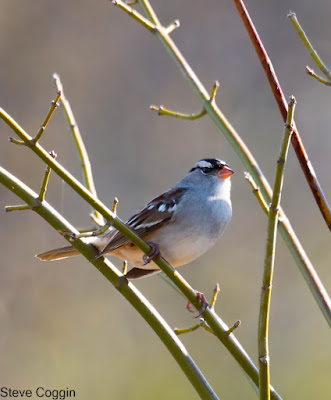 |
| A male Northern Cardinal (Cardinalis cardinalis). This bird's crest is laying down, showing he is relaxed. Mecklenburg County, North Carolina. |
Crests and crowns. Birds use them to attract mates, scare off rivals and maybe just to look good. Northern Cardinals (Cardinalis cardinalis) and their desert dwelling relatives, Pyrrhuloxias (Cardinalis sinulatus) have impressive crests. Northern Cardinals are named for the Cardinals of the Catholic Church, whose robes are bright red. Only the male Northern Cardinal is red, the female is brown with some red in her crest, wings and tail. Both sexes have impressive crests they can raise and lower as the situation demands.
 |
| A female Northern Cardinal bathing in a stream. Her crest is raised as she enjoys the water. Salineno Wildlife Preserve, Starr County, Texas. |
 |
| A female Pyrrhuloxia (Cardinalis sinulatus). Portal, Arizona. |
 |
| A male Pyrruloxia. Portal, Arizona. |
Pileated Woodpeckers (Dryocopus pileatus) are large, loud and have impressive red crests. In fact, the name pileated refers to its crest, the pileum.
 |
| A Pileated Woodpecker (Dryocopus pileatus) with its brilliant red crest. Palm Beach County, Florida. |
Many Tyrant Flycatchers (Family Tyrannidae) have a prominent crest. Eastern Phoebes (Sayornis phoebe) are small, gray flycatchers with a crest. They live in eastern North America and are often found near water. They sally forth from exposed perches and pick insects from the air. Great-crested Flycatchers (Myiarchus crinitus) are another species of eastern flycatcher with rich brown wings, a gray head and yellow belly. Despite their name, flycatchers prefer to eat beetles, butterflies and bees. This family also includes several species of kingbirds who are natural crown wearers. Kingbirds have a crest topped by a crown of red feathers that are seen when the bird is agitated.
 |
| Eastern Phoebe (Sayornis phoebe). Mecklenburg County, North Carolina. |
 |
| Great-crested Flycatcher (Myiarchus crinitus). Catawba College Ecological Preserve, Rowan County, North Carolina. |
 |
| Couch's Kingbird (Tyrannus couchii). Aransas National Wildlife Refuge, Texas. |
Titmice (genus Baeolophus)
are small, gray, North American songbirds.
There are five species of titmice and they are all crested. In the east we have the Tufted Titmouse (Baeolophus
bicolor). The Black-crested Titmouse
(Baeolophus atricristatus) is found from southern Oklahoma, down through Texas
and into Mexico. This bird is very
similar to the Tufted Titmouse except for the black crest. In fact, they were considered the same species until 2002. I think the most impressive member of the genus is the Bridled
Titmouse (Baeolophus wollweberi).
It is found in the deserts and mountains of southern Arizona, New Mexico
and Old Mexico. The Bridled Titmouse is
typical of the genus from the neck down, but its head has jaunty black and
white stripes that extend up its peaked crest.
 |
| Tufted Titmouse (Baeolohus bicolor). Rowan County, North Carolina. |
 |
| Black-crested Titmouse (Baeolophus atricristatus). Salineno Wildlife Refuge, Starr County, Texas. |
 |
| Bridled Titmouse (Baeolophus wollweberi). Patagonia Lake State Park, Arizona. |
Two species of waxwings are found in North America. Cedar Waxwings (Bombycilla cedrorum) breed in southern Canada and the northern United States. They winter in much of the United States and south to Central America. These beautiful birds look very smooth, as if they were a carving. Cedar Waxwings are brown and gray with a black mask and yellow tips on the tail feathers. Adult Cedar Waxwings have a red waxy spot on the wing feathers. Cedar Waxwings have a crest that often lays flat on the head. The diet of Cedar Waxwings is mostly fruit, but they also eat the small, fleshy cones of junipers and cedars.
 |
| Cedar Waxwing (Bombycilla cedrorum) showing its crest and red wax spots on the wings. Catawba College Ecological Preserve, Rowan County, North Carolina. |
 |
| Bohemian Waxwing (Bombycilla garrulus) eating European Mountain Ash (Sorbus aucuparia). Lake County, Minnesota. |
 |
| Two Cedar Waxwings and a Bohemian Waxwing in a Christmas card pose. Lake County, Minnesota. |
Golden-crowned Sparrows (Zonotrichia atricapilla) are a western species that breeds in Alaska and western Canada. They winter down the west coast of the United States and into Baja, Mexico. Male and female Golden-crowned Sparrows have similar plumage with brown wings and tail, gray breast, black head and, of course, that golden crown.
 |
| A Golden-crowned Sparrow (Zonotrichia atricapilla) perched on a road sign. Nome, Alaska. |
White-crowned Sparrows (Zonotrichia leucophrys) are close relatives of Golden-crowned Sparrows. They breed across northern North America, the Rocky Mountains and the west coast. These sparrows are highly migratory and winter throughout most of the United States and into Mexico. White-crowned Sparrows have a small pink beak, with black and white stripes on the head including a bold white crown.
 |
| White-crowned Sparrow (Zonotrichia leucophrys) Forsyth County, North Carolina. |
These crowned birds impress us
just by going about their daily activity, much as human royals do. So when you are out and about, watch for
crests and crowns.
No comments:
Post a Comment